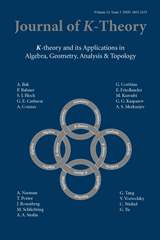Article contents
Higher spectral flow and an entire bivariant JLO cocycle
Published online by Cambridge University Press: 13 November 2012
Abstract
For a single Dirac operator on a closed manifold the cocycle introduced by Jaffe-Lesniewski-Osterwalder [19] (abbreviated here to JLO), is a representative of Connes' Chern character map from the K-theory of the algebra of smooth functions on the manifold to its entire cyclic cohomology. Given a smooth fibration of closed manifolds and a family of generalized Dirac operators along the fibers, we define in this paper an associated bivariant JLO cocycle. We then prove that, for any l ≥ 0, our bivariant JLO cocycle is entire when we endow smoooth functions on the total manifold with the Cl+1 topology and functions on the base manifold with the Cl topology. As a by-product of our theorem, we deduce that the bivariant JLO cocycle is entire for the Fréchet smooth topologies. We then prove that our JLO bivariant cocycle computes the Chern character of the Dai-Zhang higher spectral flow.
- Type
- Research Article
- Information
- Copyright
- Copyright © ISOPP 2012
References
- 5
- Cited by


